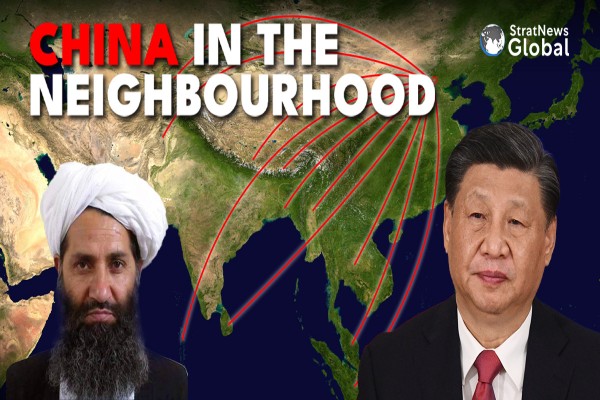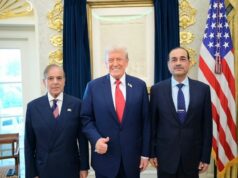China’s patient wooing of the Taliban in Afghanistan appears to be finally paying off.
On July 24, Chinese ambassador Zhao Xing, accompanied by senior Taliban officials, other diplomats, businessmen and engineers gathered at Mes Aynak – about 45 km south of Kabul in Logar Province — to launch a project to start mining the world’s second-largest deposit of copper.
Access to Afghanistan’s massive untapped resources of oil, gas and minerals is one of Beijing’s three core focus areas in Afghanistan. The other two are connectivity and security.
Mes Aynak is also famous for the ruins of an ancient Buddhist city which sits atop 450 million metric tonnes of copper ore, estimated to be worth anything between 50 to 80 billion USD.
In fact, the people who lived there two thousand years ago mined the same copper which now puts the ruins of their city–which includes numerous monasteries, stupas and small forts–at risk. Traces of a Bronze age settlement and a Zoroastrian fire temple have also been found in the region.
In November 2007, a Chinese state-owned conglomerate offered a $3.4 billion bid to for a 30-year lease to develop the mine. The ambitious plan, approved by the government of then president Hamid Karzai, envisaged production in five years, and included building the infrastructure –like a power plant and railway line–to process the raw copper before exporting it.
China consumes more than 50 per cent of the world’s production of copper.
But the project stalled due to the worsening security situation in the country, and by 2014, China withdrew its staff from Afghanistan and shifted focus—and funding –to the China-Pakistan Economic Corridor.
Apart from copper, Afghanistan has significant oil and gas as well as mineral reserves including iron ore, lithium and rare earths, which are largely unexploited due to political and economic instability, security issues, lack of infrastructure and a trained workforce, and massive corruption.
Soon after the return of the Taliban to power in August 2021, the Islamic outfit’s Minister for Mining and Petroleum pushed for the revival of the Mes Aynak project.
Ziad Rashidi, the ministry’s director of foreign relations, had at least two virtual meetings with the Chinese consortium, urging it to revive the plan on the basis of the 2008 contract.
Beijing didn’t need much convincing.
“Economic and trade relations between the two countries are becoming increasingly close,” ambassador Zhao Xing said at the ribbon-cutting ceremony.
And perhaps in a nod to the global outrage that followed the Taliban’s shelling of the ancient Buddha statues in March 2001 at Bamiyan, some 215 km east of Mes Aynak, during the Taliban’s first stint in power, both sides made it a point to stress that efforts would be made to preserve the historical heritage of the area.
“The Islamic Emirate has made tireless efforts in this regard to both protect historical artifacts and utilize our mines for the benefit of the people,” declared Khairullah Khairkhwa, the acting Minister of Information and Culture.
“The Mes Aynak Copper area has a historical background and holds special value in tourism, handicrafts, cultural development, and the Silk Road. I appreciate the Afghan government for protecting historical monuments and striving to preserve the artifacts of Mes Aynak at the governmental and global levels,” added Chinese Vice Minister of Culture and Tourism Li Qun, who was also present at the ceremony.
Less than a week later, on July 28, interior minister Sirajuddin Haqqani, head of the much-feared Haqqani network met the Chinese Ambassador to reassure him about security of the Mes Aynak project.
But Mes Aynak is just one example of China’s increasing political, strategic and economic leverage in a country which is ignored as a basket case by most western nations.
In 2023 the Taliban signed a 25-year deal with China’s Xinjiang Central Asia Petroleum and Gas Company to drill for oil in the country’s Amu Darya basin.
Later that year, the Taliban announced that a Chinese company was willing to invest $10 Billion in Lithium extraction from Afghanistan. And as a bonus, the company offered to repair the Salang tunnel –a vital link to north Afghanistan and then onwards to Central Asia, within seven months.
These strategic infrastructure projects align neatly with Chinese President Xi Jinping’s flagship Belt and Road Initiative (BRI), a massive infrastructure project aimed at connecting China with the world.
But the original plan to link the Afghan BRI project with the CPEC, thus connecting the Pakistani port of Gwadar with Central Asia, seems difficult given the growing animosity between Kabul and Islamabad. Beijing’s attempts to mediate between the two have not had much impact so far.
Another critical security concern for China is the presence of the East Turkistan Islamic Movement (ETIM) – a Muslim separatist group based in China’s Xinjiang province– in Afghanistan, as well as other assorted Islamic terrorist outfits like the Al Qaeda and the Islamic State, that have flocked to the country since the Taliban returned to power.
Beijing has repeatedly urged Afghanistan to act firmly against terrorists, including the ETIM, and protect Chinese citizens. Kidnapping foreigners for ransom by local tribal groups are also on the rise, posing a threat to Chinese workers in remote parts of Afghanistan.
The Taliban itself faces a growing challenge from pro-democracy groups such as the National Resistance Front and Afghanistan Freedom Front, which have started attacking Kabul and other cities.
Despite these hurdles, China’s engagement in Afghanistan is expected to grow, driven by the country’s abundant resources, its strategic location, and the lack of competition.
An Indian consortium, which had won the rights to mine three blocks of the Haigaz iron ore mines in Bamiyan province during the Karzai regime, and planned to invest $10 billion in the project. But due to security concerns, and despite overtures by the Taliban after it came to power in Kabul, the project has remained in limbo.
Beijing appears to have either overcome those security concerns, or is convinced that the Taliban can indeed guarantee the security of their workers in the country.
But despite all the Chinese investment, there are concerns over whether the Taliban will allow Chinese nationals to handle all their projects in Afghanistan or insist on employment opportunities for local Afghans, says Anant Mishra, a Visiting Fellow at the International Centre for Policing and Security at the University of South Wales.
China might then use the excuse of humanitarian aid to provide train Afghans to operate earth moving equipment instruments needed for excavation. This would in turn allow the Taliban to deploy these people in other mining projects, he said.
At the same time, there is a possibility of Beijing expanding its diplomatic presence by establishing commercial centres in Mazar-e-Sharif, Kandahar, Helmand, Kapisa and Wardak, putting it in a unique position to forge mining deals with the Taliban.
Then there’s also the issue of uncertainty of geographical data, making it difficult to identify sites for excavation with extensive, and expensive, exploration and surveys.
Besides excavation, setting up stable processing and transportation facilities will involve a lot of investment and time, which could stretch to a decade, he argues.
Two Afghan traders recently told Misra that Beijing might offer liquid cash to the Taliban in return for greater access to minerals and denial of similar rights to other competitors, said Mishra.
But as another expert pointed out, there’s a reason that Afghanistan is called the Graveyard of Empires. Will China be able to succeed where major powers from the Erstwhile Soviet Union and the British Empire, and more recently, the world’s solitary superpower, the United States, could not?
In a career spanning three decades and counting, Ramananda (Ram to his friends) has been the foreign editor of The Telegraph, Outlook Magazine and the New Indian Express. He helped set up rediff.com’s editorial operations in San Jose and New York, helmed sify.com, and was the founder editor of India.com.
His work has featured in national and international publications like the Al Jazeera Centre for Studies, Global Times and Ashahi Shimbun. But his one constant over all these years, he says, has been the attempt to understand rising India’s place in the world.
He can rustle up a mean salad, his oil-less pepper chicken is to die for, and all it takes is some beer and rhythm and blues to rock his soul.
Talk to him about foreign and strategic affairs, media, South Asia, China, and of course India.





